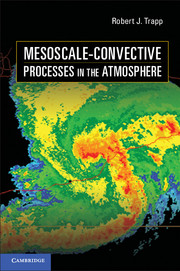Book contents
- Frontmatter
- Contents
- Preface
- 1 The Atmospheric Mesoscale
- 2 Theoretical Foundations
- 3 Observations and Mesoscale Data Analysis
- 4 Mesoscale Numerical Modeling
- 5 The Initiation of Deep Convective Clouds
- 6 Elemental Convective Processes
- 7 Supercells
- 8 Mesoscale Convective Systems
- 9 Interactions and Feedbacks
- 10 Mesoscale Predictability and Prediction
- References
- Index
- Plate section
5 - The Initiation of Deep Convective Clouds
Published online by Cambridge University Press: 05 March 2013
- Frontmatter
- Contents
- Preface
- 1 The Atmospheric Mesoscale
- 2 Theoretical Foundations
- 3 Observations and Mesoscale Data Analysis
- 4 Mesoscale Numerical Modeling
- 5 The Initiation of Deep Convective Clouds
- 6 Elemental Convective Processes
- 7 Supercells
- 8 Mesoscale Convective Systems
- 9 Interactions and Feedbacks
- 10 Mesoscale Predictability and Prediction
- References
- Index
- Plate section
Summary
Synopsis: This chapter considers the basic problem of how moist air becomes positively buoyant and thereafter rises freely in the form of a deep convective cloud. Following a review of parcel theory, much of the discussion in this chapter regards the means by which air parcels are “lifted” some vertical distance so that they become positively buoyant. Synoptic-scale processes provide weak lifting, but mostly serve to precondition the thermodynamic environment. Orographic lifting is the canonical example, whereby air parcels are forced to rise as they encounter sloped terrain. Other lifting mechanisms include horizontal convective rolls, gravity waves, horizontal outflow due to other convective storms, and relatively larger-scale fronts, drylines, and sea-breeze fronts. As shown, these mechanisms may operate individually or in tandem.
Parcel Theory
Paramount to studies of convective processes is the origin of the deep cumuli that subsequently organize into convective storms. Such convection initiation (CI) is a topic that is treated separately here, even though some of the concepts will be used in later chapters to explain the sustenance and longevity of storms.
- Type
- Chapter
- Information
- Mesoscale-Convective Processes in the Atmosphere , pp. 121 - 161Publisher: Cambridge University PressPrint publication year: 2013
- 1
- Cited by



